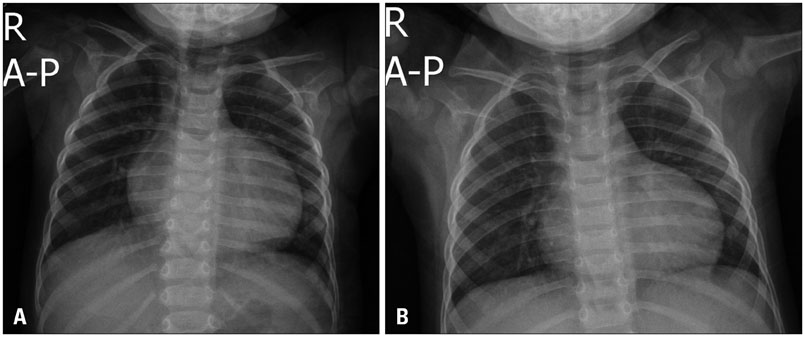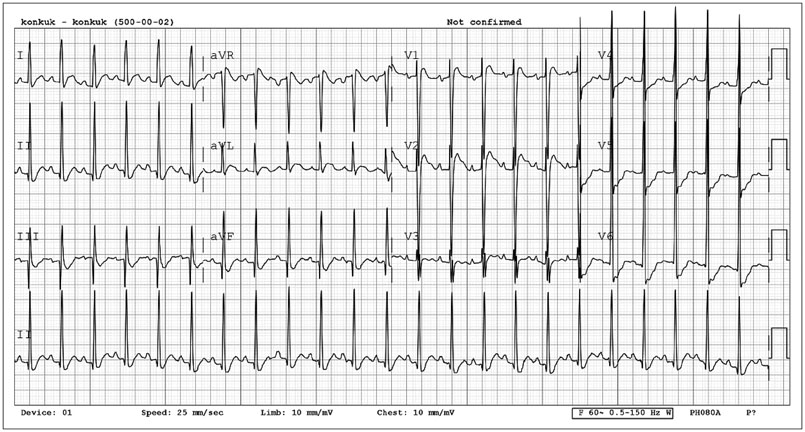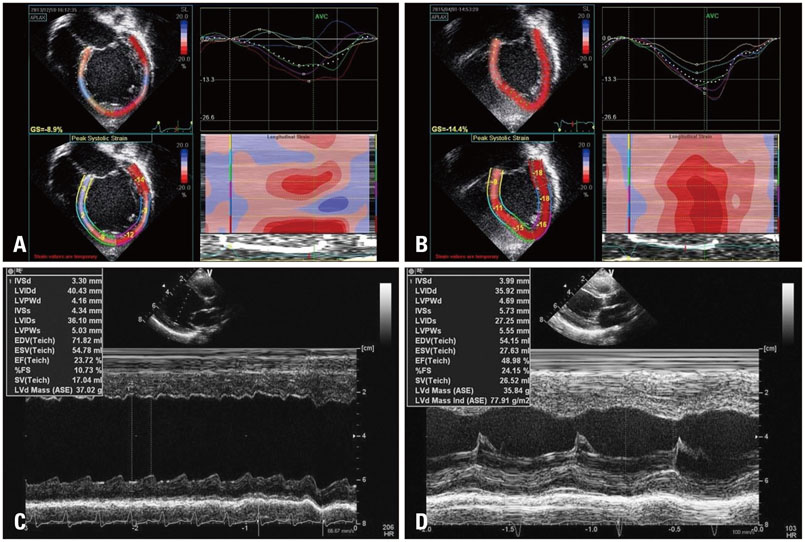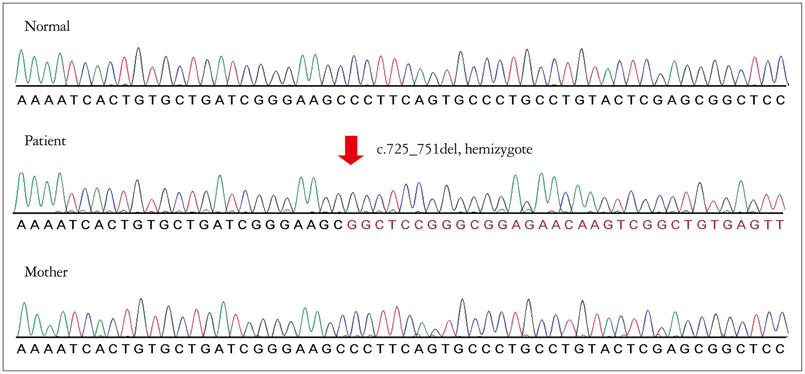J Cardiovasc Ultrasound.
2016 Jun;24(2):153-157. 10.4250/jcu.2016.24.2.153.
Identification of a Novel De Novo Mutation of the TAZ Gene in a Korean Patient with Barth Syndrome
- Affiliations
-
- 1Department of Pediatrics, Konkuk University Medical Center, Konkuk University School of Medicine, Seoul, Korea. drsonped@kuh.ac.kr
- 2Department of Laboratory Medicine, Seoul National University Hospital, Seoul, Korea.
- KMID: 2308705
- DOI: http://doi.org/10.4250/jcu.2016.24.2.153
Abstract
- Barth syndrome (BTHS) is a rare genetic disorder characterized by various types of cardiomyopathy, neutropenia, failure to thrive, skeletal myopathy, and 3-methylglutaconic aciduria. BTHS is caused by loss-of-function mutations in the tafazzin (TAZ) gene located on chromosome Xq28, leading to cardiolipin deficiency. We report a 13-month-old boy with BTHS who had a novel de novo mutation in the TAZ gene. To the best of our knowledge, this is the first reported case of a BTHS patient with a de novo mutation in Korea. This report will contribute towards expanding the knowledge on the mutation spectrum of the TAZ gene in BTHS.
Keyword
MeSH Terms
Figure
Reference
-
1. Barth PG, Scholte HR, Berden JA, Van der Klei-Van Moorsel JM, Luyt-Houwen IE, Van't Veer-Korthof ET, Van der Harten JJ, Sobotka-Plojhar MA. An X-linked mitochondrial disease affecting cardiac muscle, skeletal muscle and neutrophil leucocytes. J Neurol Sci. 1983; 62:327–355.2. Aprikyan AA, Khuchua Z. Advances in the understanding of Barth syndrome. Br J Haematol. 2013; 161:330–338.3. barthsyndrome.org [Internet]. Human TAZ gene variants database. updated 2015 Mar 28. cited 2015 Jul 10. Available from: http://www.barthsyndrome.org./science--medicine/human-taz-gene-variants-database.4. Kelley RI, Cheatham JP, Clark BJ, Nigro MA, Powell BR, Sherwood GW, Sladky JT, Swisher WP. X-linked dilated cardiomyopathy with neutropenia, growth retardation, and 3-methylglutaconic aciduria. J Pediatr. 1991; 119:738–747.5. Bolhuis PA, Hensels GW, Hulsebos TJ, Baas F, Barth PG. Mapping of the locus for X-linked cardioskeletal myopathy with neutropenia and abnormal mitochondria (Barth syndrome) to Xq28. Am J Hum Genet. 1991; 48:481–485.6. Clarke SL, Bowron A, Gonzalez IL, Groves SJ, Newbury-Ecob R, Clayton N, Martin RP, Tsai-Goodman B, Garratt V, Ashworth M, Bowen VM, McCurdy KR, Damin MK, Spencer CT, Toth MJ, Kelley RI, Steward CG. Barth syndrome. Orphanet J Rare Dis. 2013; 8:23.7. Barth PG, Valianpour F, Bowen VM, Lam J, Duran M, Vaz FM, Wanders RJ. X-linked cardioskeletal myopathy and neutropenia (Barth syndrome): an update. Am J Med Genet A. 2004; 126A:349–354.8. Neuwald AF. Barth syndrome may be due to an acyltransferase deficiency. Curr Biol. 1997; 7:R465–R466.9. Vreken P, Valianpour F, Nijtmans LG, Grivell LA, Plecko B, Wanders RJ, Barth PG. Defective remodeling of cardiolipin and phosphatidylglycerol in Barth syndrome. Biochem Biophys Res Commun. 2000; 279:378–382.10. Jefferies JL. Barth syndrome. Am J Med Genet C Semin Med Genet. 2013; 163C:198–205.11. Sakamoto O, Kitoh T, Ohura T, Ohya N, Iinuma K. Novel missense mutation (R94S) in the TAZ (G4.5) gene in a Japanese patient with Barth syndrome. J Hum Genet. 2002; 47:229–231.12. Cantlay AM, Shokrollahi K, Allen JT, Lunt PW, Newbury-Ecob RA, Steward CG. Genetic analysis of the G4.5 gene in families with suspected Barth syndrome. J Pediatr. 1999; 135:311–315.13. Kim GB, Kwon BS, Bae EJ, Noh CI, Seong MW, Park SS. A novel mutation of the TAZ gene in Barth syndrome: acute exacerbation after contrast-dye injection. J Korean Med Sci. 2013; 28:784–787.14. Spencer CT, Bryant RM, Day J, Gonzalez IL, Colan SD, Thompson WR, Berthy J, Redfearn SP, Byrne BJ. Cardiac and clinical phenotype in Barth syndrome. Pediatrics. 2006; 118:e337–e346.15. Rigaud C, Lebre AS, Touraine R, Beaupain B, Ottolenghi C, Chabli A, Ansquer H, Ozsahin H, Di Filippo S, De Lonlay P, Borm B, Rivier F, Vaillant MC, Mathieu-Dramard M, Goldenberg A, Viot G, Charron P, Rio M, Bonnet D, Donadieu J. Natural history of Barth syndrome: a national cohort study of 22 patients. Orphanet J Rare Dis. 2013; 8:70.16. Huhta JC, Pomerance HH, Barness EG. Clinicopathologic conference: Barth syndrome. Fetal Pediatr Pathol. 2005; 24:239–254.17. Mazurová S, Tesařová M, Magner M, Houšt'ková H, Hansíková H, Augustínová J, Tomek V, Vondráčková A, Zeman J, Honzík T. Novel mutations in the TAZ gene in patients with Barth syndrome. Prague Med Rep. 2013; 114:139–153.
- Full Text Links
- Actions
-
Cited
- CITED
-
- Close
- Share
- Similar articles
-
- A Novel Mutation of the TAZ Gene in Barth Syndrome: Acute Exacerbation after Contrast-Dye Injection
- Left Ventricular Noncompaction Complicated with Myocardial Infarction with Barth Syndrome in a Newborn
- Familial hyperkalemic periodic paralysis caused by a de novo mutation in the sodium channel gene SCN4A
- De novo HCN1 Mutation Identified by Next-Generation Sequencing in a Patient with Early Infantile Epileptic Encephalopathy: Case Report
- Early-Onset Parkinson’s Disease in a Patient With a De Novo Frameshift Variant of the ANKRD11 Gene and KBG Syndrome






